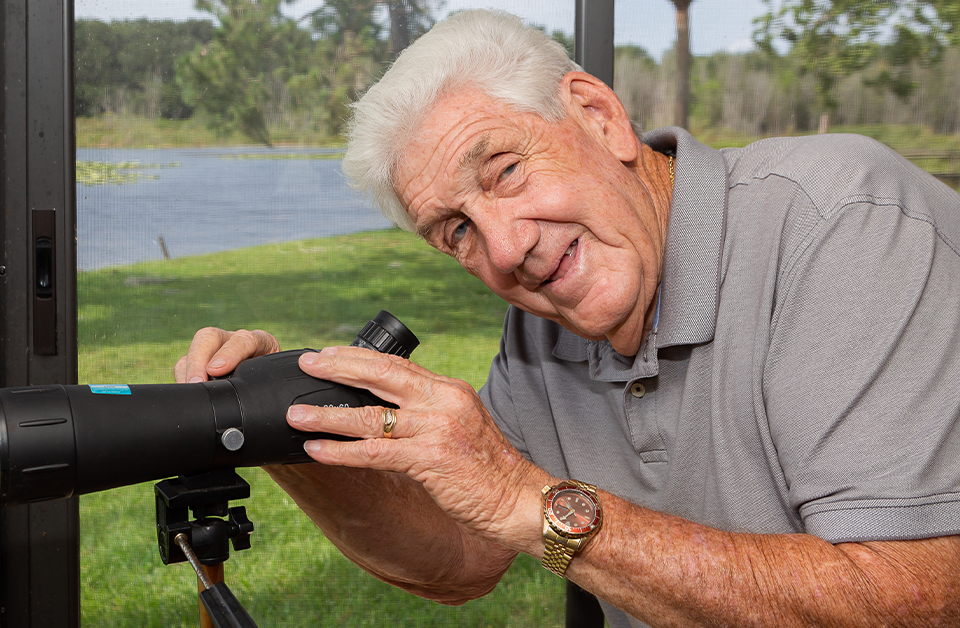

JORDAN PYSZ / iFoundMyDoctor.com
To stay active, Hilda walks up and down every aisle at the supermarket. She receives routine eye injections and understands it is the price she has to pay to maintaining her vision with wet AMD.
The 117th running of the Boston Marathon will forever be remembered for the tragedy that arose after two homemade pressure-cooker bombs were detonated a short distance from the 26.2-mile course’s Boylston Street finish line.
When the deadly explosions occurred within 14 seconds of one another at 2:49 p.m. that fateful day – April 15, 2013 – Hilda Marrigan was right in the thick of things.
“At the time, I was working at a restaurant on Boylston Street,” Hilda remembers. “When the bombs went off, everything stopped, and it became a madhouse in the street. It was awful, but it’s the most notable event that’s happened in my life.”
A decade later, the memories of that day are still vivid in Hilda’s mind. Despite moving to Florida to escape the rugged New England winters, she has been unable to completely escape the tragedy.
“My husband and I were snowbirds for a while, but after my husband died, I sold the house up north and moved everything I had down here. Now, I’m a Floridian. I love it here. It’s the place for retirees like me.
“I especially like the weather, of course. It’s almost always walkable and enjoyable with the sun shining most of the time.
“And where I live in The Villages®, the people are wonderful. I have a lot of friends, and we do many things together, including monthly luncheons.”
A neighbor drives Hilda to her doctor’s appointments. At one of those visits, Hilda received a big surprise. Though she was not experiencing any obvious symptoms, the doctor detected a serious eye problem.
“The doctor with my local eye group looked at me and said, You have macular degeneration,” Hilda remembers. “I didn’t really have any symptoms. There were little spots in my vision occasionally, but it was nothing that annoyed me.”
The retina is a layer of nerve tissue at the back of the eye that converts light into the electrochemical signals the brain translates into visual images. Macular degeneration is a weakening of the macula, the center part of the retina that processes sharp, straight-ahead vision.
Hilda’s eye doctor gave her the names of several specialists she could consult. She chose Florida Retina Institute, which has offices in Lady Lake, Mount Dora, Clermont and other locations across the state.
At the institute, Hilda met with board-certified, fellowship-trained retina specialist Alexander C. Barnes, MD, who conducted a thorough examination and diagnosed Hilda with age-related macular degeneration (AMD or ARMD).
Gradually Progressive
AMD is named because its prevalence increases with age. It primarily affects older individuals and is one of the leading causes of vision loss in people over 50. In addition to older people, Caucasians are at a higher risk, Dr. Barnes points out.
“There are also environmental risk factors, such as ultraviolet sun exposure and smoking,” the doctor adds. “There are genetic factors as well. People with family members with AMD are at a greater risk for developing the disease.”
Treating AMD is important for maintaining quality of life, he explains, because it affects a person’s central vision, which is needed for reading, driving, recognizing faces and doing close-up tasks. Typically, people with AMD start to notice changes to their central vision.
“People may experience some distortion in vision, which is usually what brings them to the eye doctor,” Dr. Barnes describes.
AMD is categorized as wet or dry, and each form weakens the macula differently.
“About 85 percent of patients diagnosed with AMD have the dry form, which occurs due to natural degenerative changes to the retina,” Dr. Barnes states. “Dry AMD is gradually progressive and is frequently discovered on a routine screening.”
With dry AMD, small, yellowish deposits of cellular material called drusen are often present under the macula. A doctor can see drusen during an eye exam.
In most cases, AMD causes minimal problems with eyesight, but people may suffer from blurred vision or see blank spots in their central vision. In addition, straight lines may appear wavy.
There is no cure for dry AMD, but its progression may be slowed with a vitamin supplement called AREDS2, which was developed by National Eye Institute researchers in a six-year clinical trial called Age-Related Eye Disease Study 2.
“This vitamin formulation contains antioxidants and minerals that can reduce the risk for progression of the disease,” Dr. Barnes asserts. “In addition to taking these vitamins, we recommend certain lifestyle modifications, such as quitting smoking, to help slow disease progression.”
Geographic Atrophy
Until recently, there was no treatment for dry AMD beyond the vitamin supplements. However, the FDA in 2023 approved two injectable medications for an advanced form called geographic atrophy (GA): SYFOVRE® (pegcetacoplan injection) and IZERVAY™ (avacincaptad pegol).
“With geographic atrophy, the cells involved in transmitting visual information to the brain are no longer functional; they’ve atrophied, or degenerated,” Dr. Barnes says. “Symptoms of GA include a decrease in sharpness of vision; difficulty reading, driving or doing other activities that require central vision; trouble seeing in dim light; a blurred or blank spot in the field of vision; and decreased brightness of colors.
-Dr. Barnes
“These medications slow disease progression but do not cure the condition. They’re given as injections into the eye and must be performed every month or two months in perpetuity. It is exciting to have these new therapies available.”
In rare cases, dry AMD can progress to the more serious wet form of the disease.
“Wet AMD tends to come on suddenly,” Dr. Barnes informs. “People are doing fine and then wake up one day to discover changes to their central vision. With the wet form, there is a network of abnormal blood vessels growing underneath the retina. These vessels leak blood and fluid into the retina and macula, which can damage vision.”
Symptoms of wet AMD include a distortion of vision (straight lines appear wavy), trouble while reading or doing close-up activities in low light, decreased intensity of colors, blurriness of the printed word, and a well-defined blind spot.
“With wet AMD, high levels of a protein called vascular endothelial growth factor (VEGF) are released into the eyes,” the doctor says. “VEGF promotes the growth of the abnormal blood vessels. During treatment, anti-VEGF medications are injected into the eye, which blocks the new vessel growth.”
Anti-VEGF medications stabilize the abnormal blood vessels so they don’t leak or bleed. While vision may improve, the treatment’s goal is stabilization and prevention of degeneration.
“They Don’t Hurt”
While examining Hilda, Dr. Barnes discovered that she has wet AMD in both eyes. To preserve her vision, he is treating her with injectable meds that have stabilized the disease.
The idea of receiving injections into her eyes initially terrified Hilda. She was afraid they would be painful, but her fears were allayed after the first injection.
“They don’t hurt at all,” Hilda reports. “First, Dr. Barnes numbs the area. He then inserts the needle and injects the fluid. Afterward, there are no problems at all, so I have no worries about them. I’m also happy to report that I have no issues with blurry vision between visits to Dr. Barnes.”
Dr. Barnes describes Hilda as a good patient who understands that routine injections are the price required to maintain vision with wet AMD.
“She’s doing very well,” the doctor reports. “Due to the nature of the treatment, which calls for repeated injections, retina specialists often develop a unique relationship with patients. Because Ms. Marrigan comes to the office regularly, she’s become like a family member in our clinic.
Hilda says the spots in her vision have dissipated, so she is pleased not only with the treatment, but also the provider.
“Dr. Barnes is a wonderful doctor and a wonderful young man,” she raves. “Everything he does for my eyes is for my good. When I leave the office each time, he says my eyes are getting better and better. He’s doing the right thing, and I’m all for it. I’m well taken care of at Florida Retina Institute. I highly recommend it and Dr. Barnes.”








Leave a Reply